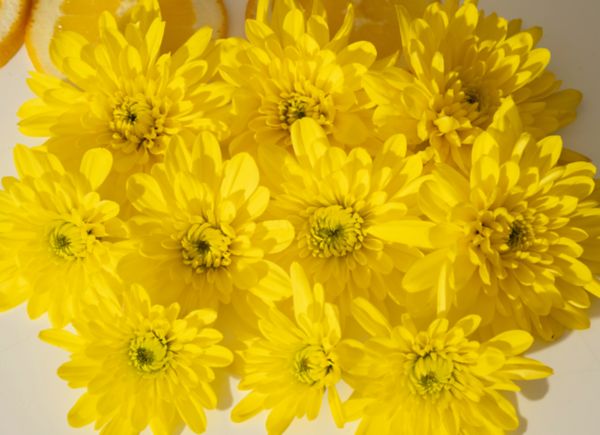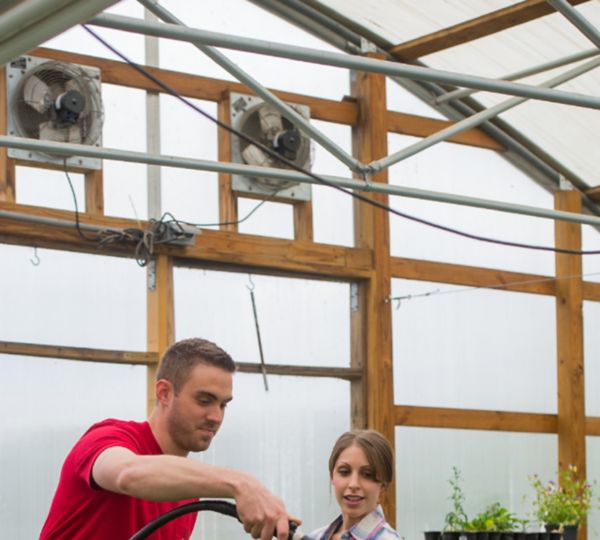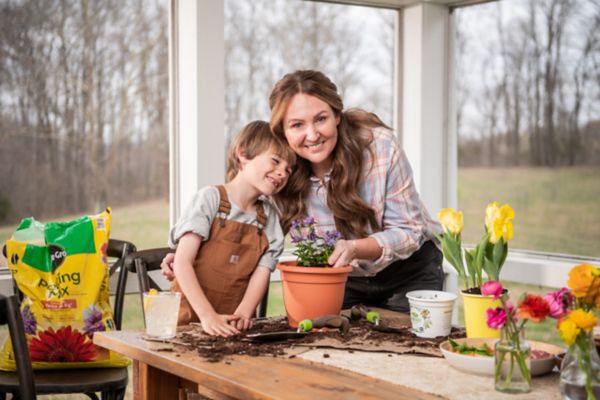Greenhouse planning guide
Authored by Leah Chester-Davis
Greenhouses are a marvel, adding a new dimension to your garden. They offer many ways to amp up any gardening effort. Not only do they help you jump-start the growing seasons, but they also extend them.
Why a greenhouse?
Not all gardeners have a greenhouse but if you are fortunate enough to enhance your gardening efforts with one you likely know the benefits. Among those many benefits:
- Space to grow plants, both ornamental and edible, year-round in an environment that keeps them happy and thriving.
- Controlled conditions when it comes to the temperature, light, moisture, soil, and protection from extreme weather conditions, giving plants the best environment.
- A place to start bedding plants for your landscape or transplants for the vegetable garden. Producing your own will broaden your gardening efforts. When you start plants from seed, you typically will have more options.
- A place to overwinter plants.
- A contributor to your well-being. Think about cold, winter days when you can enter a warm environment full of plants. It is the perfect place to putter away, caring for your plants and lifting your own spirits.
Planning for your greenhouse
There are many options and many price points when it comes to greenhouses. A glass greenhouse tucked into your landscape with beautiful plantings is a thing of beauty, no doubt. It is also perhaps the most expensive type of greenhouse. Before investing, do your homework.
What are my gardening needs and requirements?
What, specifically, do I want to grow? In what quantity?
How much time do I have to devote to gardening each week?
What is my budget?
Do I have optimal space for a greenhouse?
Your responses will give you a clue on how to proceed. If you primarily wish to overwinter houseplants, it may be best to explore options inside your home and add good lighting. On the other hand, if you have a large landscape and vegetable garden and you wish to start your own plants and you devote hours each week to gardening, a greenhouse may be the logical next step.
Types of greenhouses
There are many types of greenhouses for hobbyists and home gardeners, and just about something for every budget, from a raised bed greenhouse that may cost less than $100 to an architectural beauty that runs into the thousands. They include portable and mini greenhouses, lean-to, attached even-space or abutting, gable-roofed freestanding, Quonset, gothic arch, and A-frame. They may be made of glass, high-quality fiberglass, or plastic. See Types of Greenhouses for information on the different types and their features.
Read more about greenhouse types >
Where to put a greenhouse
The best place to locate a greenhouse is where it receives maximum sunlight. Georgia Extension reports that the most desirable site is on the south or southeast side of the house in a sunny location. That is where it will capture the most sunlight from November to February. The east side is the second best location. The next best locations are the southwest and west. The north side is the least desirable location.
Clemson Extension points out the importance of setting the greenhouse near deciduous trees, such as maple and oak, to shade the greenhouse from the intense late afternoon summer sun. Deciduous trees also allow maximum exposure to the winter sun because they shed their leaves in the fall. On the other hand, avoid sitting near evergreen trees that may shade the greenhouse.
Take the time to observe your property and where shadows may fall from any structures and trees on your property and neighboring property. Avoid heavily shaded areas or spots between two buildings where wind tunnel effects may occur.
Another consideration is what you plan to grow. According to the American Horticultural Society, if you are using the greenhouse mostly in the summer, its longest axis should run north to south. On the other hand, if you are raising annuals and vegetables in the spring or overwintering tender plants, an east-west orientation is best for good light much of the day.
Other considerations include good drainage away from the structure. Avoid low areas that are surrounded by other buildings or woods. It also needs to be located near sources of water and electricity.
Make your greenhouse convenient and accessible. A location closer to the house rather than farther away is usually best.
Choosing the size
Just as there are many types of greenhouses, there are many sizes as well. A greenhouse that is too small can be frustrating, and one that is too large can be costly. Again, think about your needs and requirements. How do you wish to use the greenhouse? Do you wish to use it to display plants? Start seeds? Grow bedding plants? It’s also important to consider your height. A greenhouse that is wide enough and tall enough to allow you to work is important. A small one that requires you to stoop, or hunch will make work less than enjoyable. A size of at least 8 feet long by 6 feet wide, with an eave height of around 10 to 12 feet is the minimum size for general purpose, traditional greenhouses, according to the American Horticultural Society. Think about how you would organize the space to meet your needs when figuring out the size of the space that you need. One of the best designs is a central walkway with staging space for benches and shelving on either side. Floor standing space for taller plants is also important.
Preparing the site
Regardless of the type of greenhouse you select, make sure the site is level and firm. This is important when it comes to reducing any problems you might have later from warped frames that can result if erected on uneven or less-than-solid ground. Depending on the type of greenhouse you install, the foundation may be pea gravel, with corner anchors set in concrete. Or it may be stone, poured concrete, paving slabs, or brick.
Creating the right environment
The right environment for your greenhouse will depend on how you are using it and what you are growing. Not all greenhouses require heat. For example, one considered cold may still be enough to overwinter plants or grow winter crops. However, a small heater may be enough to warm the greenhouse to overwinter plants, grow summer crops or start seeds. According to Georgia Extension, most plants need day temperatures of 70 to 80 degrees F, with lower night temperatures. Some plants grow best in cool greenhouses with night temperatures around 50 to 55 degrees after they are transplanted from the seeding tray. This includes many bedding plants. A warm greenhouse with nighttime temperatures of no lower than 65 degrees F is best for propagating plants, getting seedlings started, and growing a wide range of plants. Tropical plants grow best in high humidity with night temperatures of 70 degrees F.
Heating and ventilation
Another consideration is greenhouse heat and ventilation, which go hand-in-hand because one can affect the other. There are many options when it comes to the type of heat – electric, natural gas, kerosene, for example. There are also many options for the type of ventilation, such as wind, fan, or louver.
Insulation
Just as insulation in your home can help reduce heat loss and costs, the proper insulation in a greenhouse can make a difference. Among the materials used are glass, polyethylene film, fiberglass reinforced polyester, polycarbonate, acrylic, flexible plastic, sometimes called bubble plastic, and thermal screens. Each has different attributes, life spans, costs, and efficiency levels so it is important to review manufacturers’ information when considering the best choice for you.
Shading
Some type of shade is another way to help control the temperature and to protect plants from too much direct sunlight. Several materials are available, from blinds to shading washes to some type of fabric such as flexible meshes. Washes are applied to the outside, blinds can be used inside or outside but most often outside, and fabrics can be used either indoors or out.
Growing guides for vegetables, fruits, herbs, flowers and more
Organizing and stocking the greenhouse
When you get to the point that you’re ready to set up the inside of the greenhouse, the fun – growing plants – is not far away. Just with about any other phase in getting your greenhouse constructed, there are several options.
Hopefully, you thought about how you might want to organize the greenhouse as you considered the size you needed. Now, it’s time to add benches or grow tables. To optimize space, use not only the tops of benches but underneath them as well for more space for either staging plants, such as shade lovers, or for keeping pots handy.
If you have a central walkway, arrange benches on either side to make it easier to access plants that are placed on them and below them.
Several greenhouse supplies help make work in the greenhouse more efficient and enjoyable.
See our greenhouse supplies for a basic list to get started >
Use your imagination and enjoy the space
A greenhouse is a perfect complement to a garden, and it is a structure that invites all kinds of uses. While a greenhouse certainly gives gardening efforts a boost when you get vegetable seedlings and bedding plants started, it can be so much more.
If you have considered growing specialty plants such as orchids, a greenhouse will enhance those efforts. If the winter doldrums get you down, a greenhouse provides the perfect environment for beautiful floral displays. Colorful displays of plants beg for an inviting spot to place a small table to enjoy and share a meal or a glass of wine. They can be perfect places to add a comfy indoor/outdoor chair for when you’re ready for a break and wish to soak up the warmth on a winter’s day. They also become enchanting environments when you string pretty lights that play off both the structure and add a magical quality to a plant-filled space. They provide a backdrop for adding plants around the perimeter – just keep them low enough so they don’t shade the indoor plants. An attractive pathway that is lined with landscaping lends charm.






